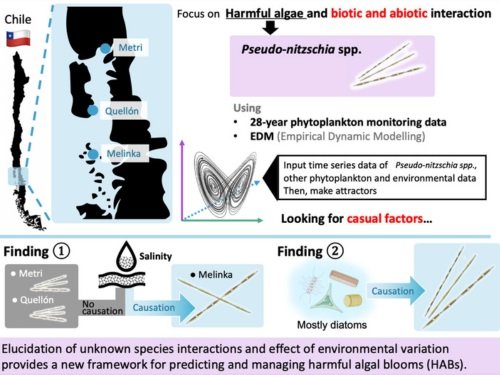Predicting HABs in a complex, changing world is difficult – there is no one solution for every situation.
The Arabian Gulf is a unique hypersaline semi-arid environment with extensive shallow regions < 20 m deep off the coasts of Kuwait, Bahrain, and the United Arab Emirates. Evaporation rates in the Gulf greatly exceed freshwater inputs by a factor of ~10. Water volume in the Gulf is maintained by seawater inflows through the Strait of Hormuz from the Sea of Oman. Harmful Algal Blooms (HABs) are often shown to extend into the Arabian Gulf from the Sea of Oman and the Arabian Sea.
In the Arabian Gulf, finfish aquaculture alone is projected to grow by over 7% between 2018 and 2024. However, the growth of the aquaculture industry is threatened by HABs, which are increasingly observed at aquaculture sites around the globe, with some HAB species causing mass fish mortalities. Numerous mass fish kills have been recorded in the Arabian Gulf and Sea of Oman and many of these coincide with blooms of ichthyotoxic HAB species and/or high biomass blooms that subsequently decay and cause oxygen depletion in the water column.
A virtual workshop was held in February focused around the development of an early warning system for Harmful Algal Blooms (HABs) in the Arabian Gulf.
The workshop explored existing knowledge and data on Harmful Algal Blooms (HABs) and impacts on fisheries and finfish aquaculture in the Arabian Gulf and Sea of Oman.
Day 1 of the workshop focused on “Understanding the susceptibility of the Arabian Gulf and Sea of Oman to harmful algal blooms and impacts on fish health and food safety”.
Day 2 focused on “Developing early warning systems (EWS) for HABs for mitigating impacts on fisheries and aquaculture”.
The organisers are pleased to announce that the Gulf HAB workshop proceedings and links to video recordings ofpresentations are now available via the GlobalHAB website. Click here (proceedings and link to videos at bottom of page).
Stay Always Informed
Join our communities to instantly receive the most important news, reports, and analysis from the aquaculture industry.
Source: Exeter University
Editor at the digital magazine AquaHoy. He holds a degree in Aquaculture Biology from the National University of Santa (UNS) and a Master’s degree in Science and Innovation Management from the Polytechnic University of Valencia, with postgraduate diplomas in Business Innovation and Innovation Management. He possesses extensive experience in the aquaculture and fisheries sector, having led the Fisheries Innovation Unit of the National Program for Innovation in Fisheries and Aquaculture (PNIPA). He has served as a senior consultant in technology watch, an innovation project formulator and advisor, and a lecturer at UNS. He is a member of the Peruvian College of Biologists and was recognized by the World Aquaculture Society (WAS) in 2016 for his contribution to aquaculture.



